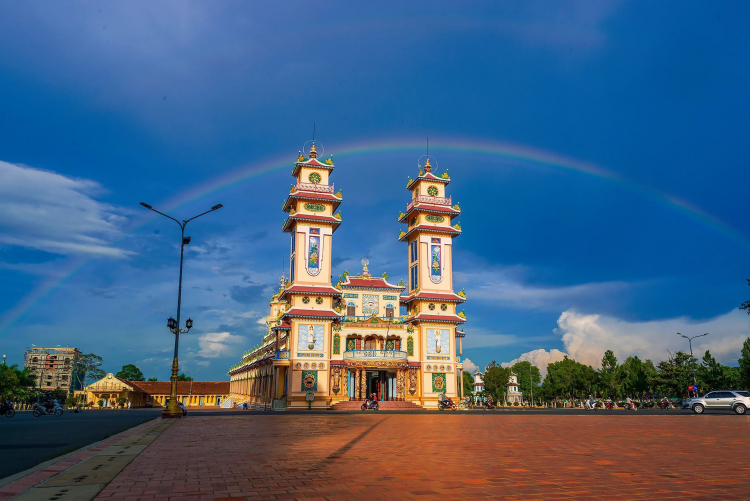Cao Dai Temple
Cao Dai Cathedral – Great Divine Temple
Known as an attraction of Ho Chi Minh city, Cao Dai temple is a famous religious site of Vietnam that attracts a lot of tourists every year.
Cao Dai Temple (also called Tay Ninh Holy See) was built in 1933 and officially inaugurated in 1955. It is a special religious work of Caodaism (Cao Dai religion), located in Hoa Thanh District, about 4km from Tay Ninh City.
In the early 1920s, Caodaism was established in Southern Vietnam but had not been officially codified until 1926. It is the 3rd largest religion in Vietnam borrowing elements of Buddhism, Christianity, Taoism, Confucianism, and Islam. It is currently estimated that there are nearly 3 million followers nationwide, living in 38 provinces and cities, mainly concentrated in South Vietnam.
The symbol of Cao Dai religion is an eye in a triangle, representing God. This divine eye is depicted in many places around the temple, especially the main door. In addition, the religion also worships Shakyamuni Buddha, Jesus Christ, Confucius, Lao Tzu, Lady Guanyin
The architecture of Cao Dai Temple is itself an attraction. The building is a combination of Neo-Gothic, Baroque and Oriental design and is very ornately decorated including dragon wrapped pillars, seven-headed cobras, and ceilings of sky blue.

There are 12 gates to Cao Dai Temple, all of which are decorated with sculptures of four sacred animals of Asian belief and lotus. The main entrance is the largest one with the words “Dai Dao Tam Ky Pho Do” in both Vietnamese and Chinese. This gate is only opened on occasions to welcome heads of states or leaders of religions.
There are architectural works around the site connected by wide roads. In a spacious courtyard, you will walk around the Buddha statues and lush gardens before reaching the Great Temple – one of the most outstanding buildings.
It is 97m long and 22m wide and characterized by three 36m-high towers and two 25m-tall pavilions sheltering steeples and drums. The Great Temple was built according to the architectural requirements of the Cao Dai Sect.
The construction is a harmonious fusion of Asian and European styles, with domes and embellishments exemplifying the spirit of the region. The floor of the temple is divided into 9 levels called “Nine Fairy Levels”.
The high domed ceiling is painted sky-blue with fluffy clouds. At the end of the temple is a large sphere, representing the universe with 3,027 stars around and the Divine Eye on it.
Beside its unique architecture, watching Caodaism prayer is one of the main highlights when visiting the temple. Most worshippers wear pure white robes while men with the rank of priest and higher have brightly colored robes reflecting their own spiritual allegiance: yellow for Buddhism, blue for Taoism or red for Confucianism.
Both the bishops and cardinals have the Divine Eye which is emblazoned on their headpieces. During worship, men are seated on the right and women on the left with all devotees seated in orderly rows.
Ritual prayers are held four times daily at 6:00 AM, noon, 6:00 PM and midnight. For day-trip visitors coming from Ho Chi Minh City, the ceremony at noon is suitable to see.
Female tourists will enter the temple through a door at the base from the left side and then roam around the outside of the colonnaded hall in a clockwise direction. Meanwhile, men will enter from the right side and move around the hall in an anticlockwise direction.
During the visit, you are able to take pictures of the prayer sessions from the upstairs balcony, but under the instructions of the priests. Remember there are some places you have no permission to take photographs.
In addition, Duc Chi Ton Great Ceremony and Dieu Tri Kim Mau Festivals are two largest annual festivals held in Cao Dai temple on the 9th day of January and the 15th day of August in the lunar calendar respectively and the full moon day of the 8th month of the lunar calendar are the two biggest festivals of the Cao Dai Temple.
The holy land of the South welcomes on these occasions thousands of followers and visitors from every corner of the country coming here to soak up in the festive atmosphere.




